
IAN BAXTER
IMAGES OF WAR. Hitler's Mountain Troops. The Gebirsjäger. Rare Photographs from Wartime Archives




Three photographs, taken in sequence, showing a motorcycle combination crossing a light wooden pontoon bridge known by the German's as a Bruckengerat 'C' type bridge. The bridge appears to be still in the process of completion as pioneers can be still seen on the bridge working. Note the pontoon boats held in place by ropes attached to the river bank.

Mountain Reconnaissance motorcyclists, of the 1.Gebirgs-Division, use a railway line for navigational purposes. Note the motorcycle combination crew checking the width brackets of the sidecar against the width of the rail line.

Gebirsjäger officers can be seen being driven across a stream. Like all Heeres vehicles, it has been provided with a registration number plate marked in black on a white six or seven-digit number. The 'WH' means it belongs to the 'Wehrmacht Heer'.

A commander can be seen standing in a Horch cross-country staff car. It appears that he has inspected his unit and is preparing to depart. Note the Heeres command flag attached to the front right of the vehicle. The flag on the left fender is a field marshal's flag.

This photograph has been taken in sequence to the above image, showing Gebirgstruppen watching the army commander depart after an inspection of their unit. They all wear the familiar standard service uniform and equipment associated with that of the Gebirsjäger.

Two photographs, taken in sequence, showing a unit on a long march. One Gebirgstruppen can be seen carrying the metal staff flag, which identifies it as part of a battalion or regimental headquarters. The colours are black, white and red with a tactical symbol in black. The infantry cart also carries the same metal staff flag.


Gebirgstruppen, with their horses, cross a stream bound for the front line. The horses are carrying a considerable quantity of equipment which was needed by the mountain troops to sustain them in some of the most inhospitable mountainous areas. The troops often had to carry several day's rations as well as additional cold weather clothing and climbing equipment.

A Horch cross country staff car crosses a pontoon bridge during its unit's onward journey. In June 1940, the Gebirgs were given the objective of striking the rear of the French troops defending the Alps against the Italians. In the distance, the mountainous region of the Alps can be seen. However, the move was immediately halted and the operation cancelled as the Franco-German armistice came into effect on 25 June. Instead, the mountain troops were given the duty of guarding the frontier and carrying out the tasks of an army operation.
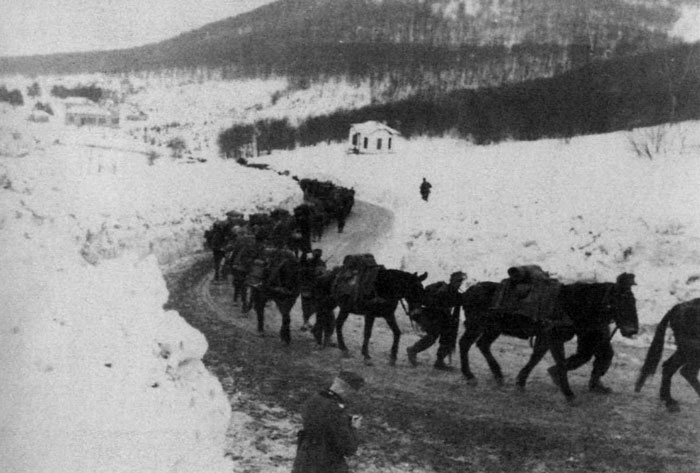
Gebirgstruppen cross into Yugoslavia and can be seen with their mules. The mules were very hardy animals and were the backbone of the Gebirsjäger divisions for transporting equipment across some of the most rugged terrain across Europe and the Soviet Union.

A long column of pack animals with their handlers on a mountain road. These animals were able to spend many hours on the march, fully laden with supplies. They not only carried rations and medical supplies, but also carried ammunition and weapons.

Heavily laden mountain troops and mule-handlers are seen trudging along a mountain road. The soldiers wear heavily loaded Bergen-type rucksacks. Unlike standard Wehrmocht soldiers, the troops were also issued with ice axes, hard-lay climbing rope, pitons and piton hammers, carabiners, and avalanche marker cords and flags for use when searching for victims.

Gebirgs mule handlers are seen with their pack animals on a winding road somewhere in the mountainous regions of the Balkans. The animals are well laden with equipment. They are all fitted with special pack harnesses which allowed the mules to carry significant amounts of equipment, in order to sustain the mountain truppen for lengthy periods of time, in some of the most inhospitable terrain.
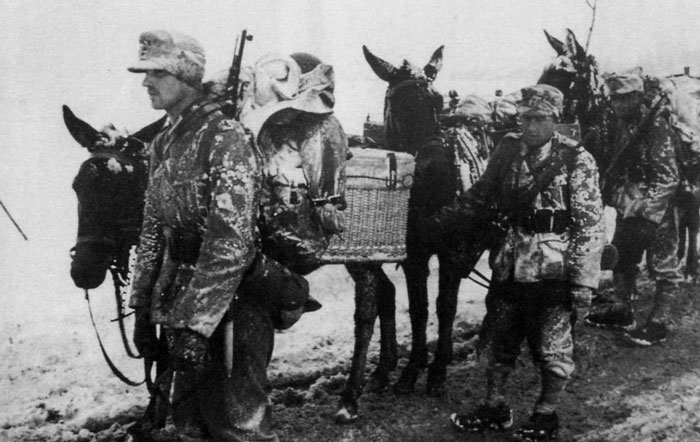
Mountain troop handlers with their pack animals along a snowy road in the mountains. The mules are wearing the special wicker carrier baskets that contained a number of supplies for sustaining the Gebirgs on their long march.

Gebirgstruppen, on horse drawn transport, along one of the many hazardous mountain roads from Bulgaria into Yugoslavia in April 1941. The steep mountain slopes and appalling snow blizzards tested the ability of the Gebirsjäger. The 1 and 4.Gebirgs-Divisions had played a crucial part in the Yugoslav campaign.
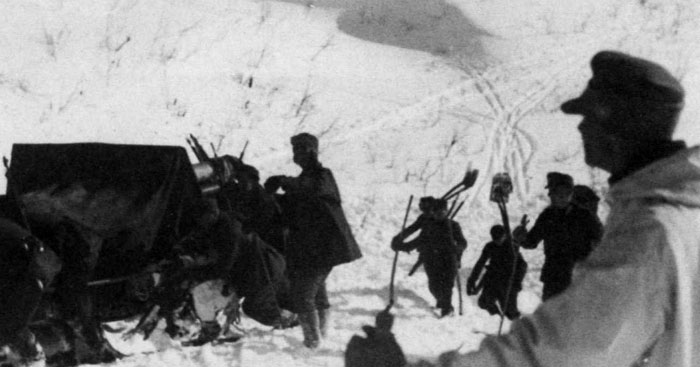
Ten photographs, taken in sequence, showing Gebirgstruppen with an unidentified artillery piece, probably of foreign design. Due to the severe weather conditions, it often took at least two dozen men just to haul one artillery piece of this size through the snow. This artillery piece is being moved by add-on sledge-like skids, but the snow and terrain are being very problematic. Pulling artillery pieces across the snow not only hindered movement of the unit to the battlefield, but frequently sapped the soldier's energy, which was already tested due to the amount of miles that had to be covered daily in some of the most perilous terrain. Yugoslavian forces too were also posing a considerable threat in a number of places, and this also was to test the skill and resilience of the German mountain trooper.






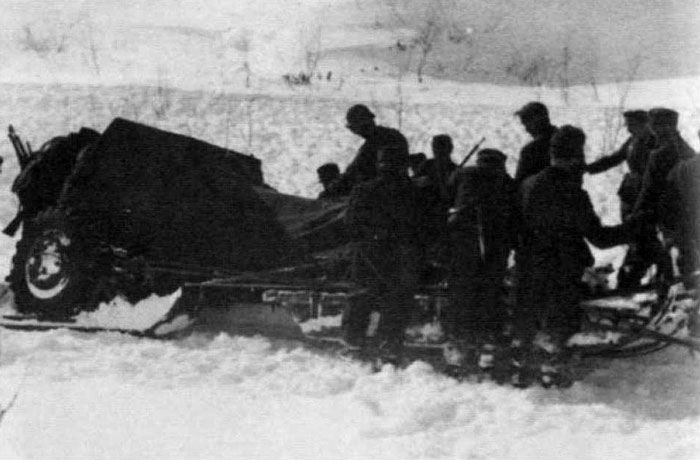
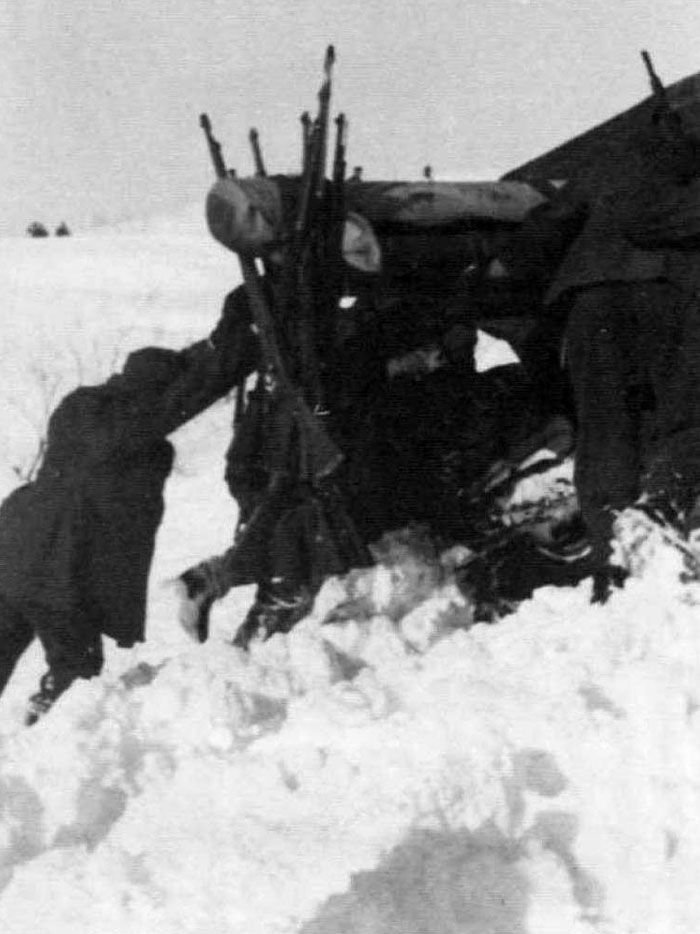

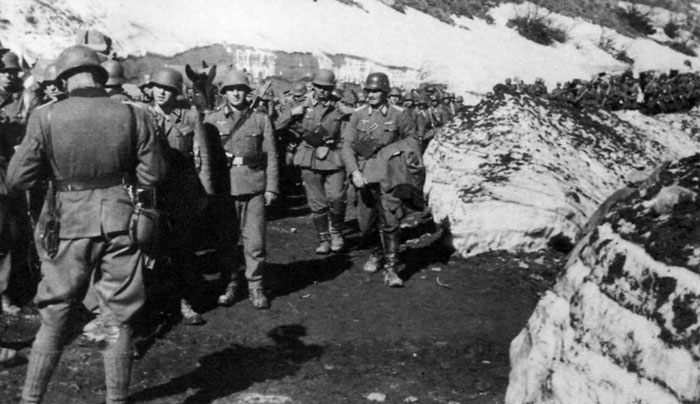
A Gebirgs unit moving along a mountain road, which can be seen cleared of snow. These troops that marched and fought in the mountains were self-sufficient and were often in a high state of physical fitness, acclimatized to extreme weather conditions, and were above average marksman.

Troops on a mountain slope pause in their exhausting march. Often the advance through the Balkans was slow and much of the troops that were traversing these mountain slopes were reduced to a crawl. This, in effect, regularly had serious implications to the conduct of fighting.
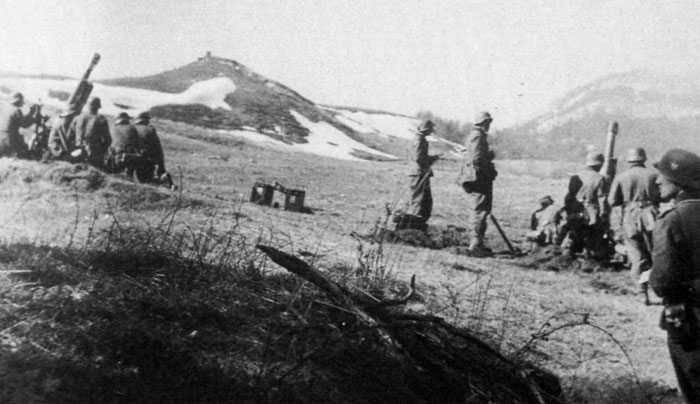
Two photographs showing a Gebirgs battery on a mountain slope somewhere in Yugoslavia. The guns positioned on the slope are 7.5cm GebG36 Gebirgschüzte. There were four or five of these guns in a mountain battery. These mountain guns were well- liked among its crews. The gun had a split trail and the recoil system was a variable system that automatically shortened the recoil as the elevation increased. The disc wheels were lightweight with solid rubber tyres, though some had wood-spoked wheels. There was no splinter shield due to the fact that the gun was primarily designed for mountain use. With no shield, this helped to keep the weight low and enabled the whole weapon to be broken down into eight loads relatively quickly.
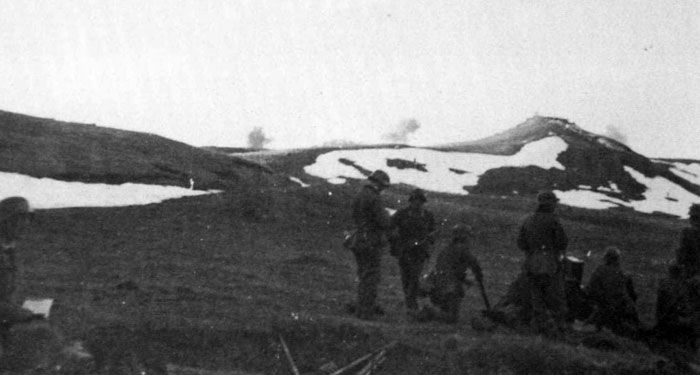
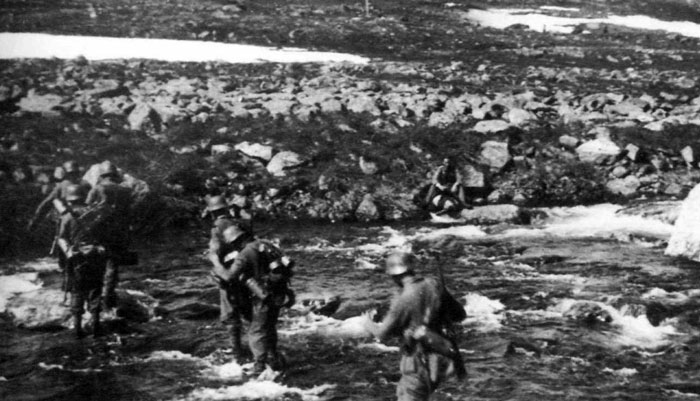
Well-equipped Gebirgstruppe cross one of the many streams that criss-crossed the mountain slopes in the Balkans. Natural obstacles such as this were a constant hindrance to the advancing units achieving their daily objectives.
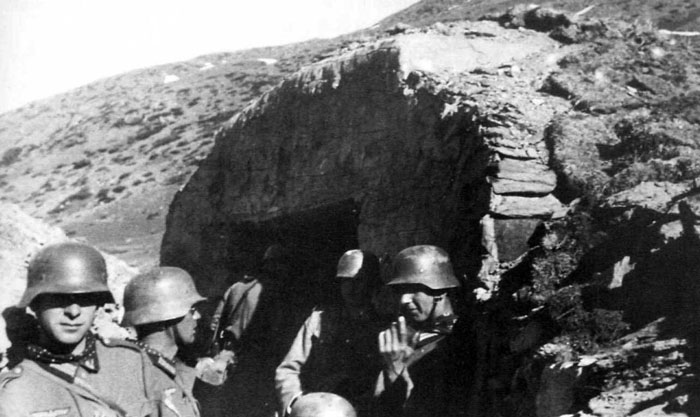
Gebirgstruppen pause along a mountain range before resuming their march, traversing the slopes towards enemy positions. Although the Yugoslavian forces were thinly stretched along their entire front, a number of units were able to put up considerable resistance. However, with no in-depth defences and few reserves, the mountain troops were able to smash through and drive onto Belgrade.
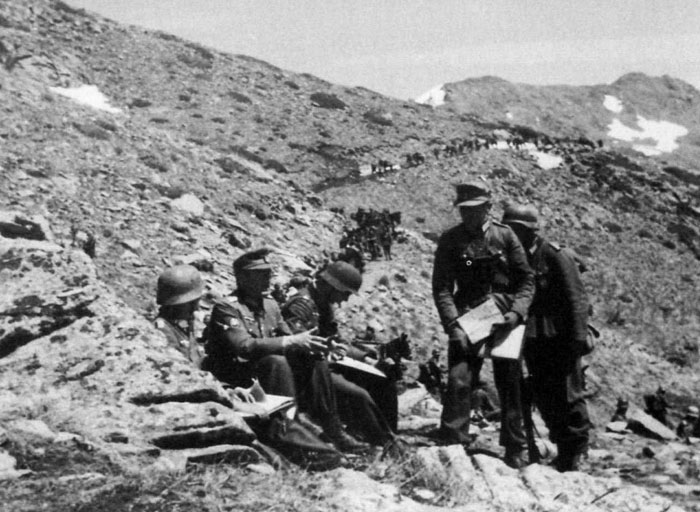
Company command troops pause in their march and converse with each other before resuming their advance down the mountain slope. It was quite common for Gebirgs unit commanders to lead an advancing column. Behind the commanders, a long column of troops and pack animals and their handlers can be seen navigating the narrow mountain road.
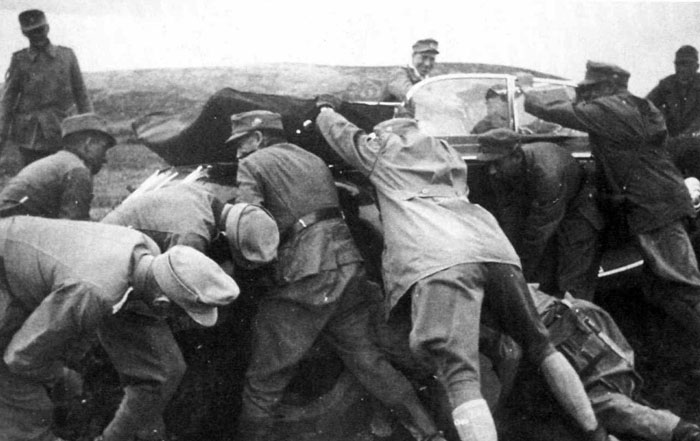
Terrain in Yugoslavia was not well suited for military traffic, especially in the mountain regions. Here, in this photograph, a Gebirgs staff vehicle has become stuck on a mountain road and a number of staff officers and their personnel are seen trying to relieve the vehicle.

Two photographs, taken in sequence, showing heavily equipped troops with heavily loaded pack animals are seen on a march along a mountain road. They pass a stone farm building with corrugated roof, but now probably being utilized by the Gebirsjäger for shelter or storage.


Five photographs showing mountain troops with captured Yugoslavian troops. Despite the terrible conditions and gallant resistance shown by the Yugoslavian Army, they were no match for the Gebirsjäger and their Wehrmacht comrades. It took the Germans just 12 days to crush the Yugoslavian force.





Two photographs, taken in sequence, showing a column of Gebirgs motorcycle combinations, which are probably part of a reconnaissance unit operating somewhere in Yugoslavia. The first photograph shows the unit following a railway line. Note the tactical symbol on the motorcycle mudguard indicating that it belongs to the 1.Kompnaie/Gebirgs-Auflarungs-Abteilung 54. The second photograph shows the troops dismounting from their motorcycles preparing to reconnoitre a hilltop castle.



Three photographs showing the 6×30 Sf. 14z Scherenfernrohr (scissor binoculars) being used in three different locations on the mountain slopes somewhere in Yugoslavia. These are more than likely a Gebirg artillery forward observation unit. A battery observation post often had two scissor binoculars for engaging an enemy target and searching and plotting for additional enemy positions. Note the tripod-mounted binoculars being used on the slope. The observer can be seen adjusting the range of the binoculars.


A long column of pack animals advance alongside a road kept clear for motorised traffic. These Gebirsjäger belong to a Sanitation Hospital unit. The wicker carrier baskets display the familiar red crosses on a white background associated with that belonging to a Sanitation unit.

Gebirgs handlers with their pack animals trudge towards the front. Painted on the wicker carrier baskets are the letters 'K.Tr' and 'Tr'. This abbreviation means 'Trager' or carrier. Behind these animals, in single column, are heavily equipped Gebirgstruppen.

Gebirgs machine gun troop are seen trudging through a mountain valley. Both leading men carry a spare MG34 barrel for their 7.9mm MG34 machine gun. These troops belong to the XVIII.Gebirgs-Korps which was attached to the 12.Armee. Their objective was to attack Greece via Yugoslavia.

A Gebirgs platoon prepare to move out during a pause in their advance. The platoon leader can be seen armed with an MP40 sub machine gun. The soldiers all wear the standard M36 uniform and special grey heavyweight trousers. On their right sleeve they display the famous Edelweiss. For their main armament, the truppen carry the Mauser 7.9mm Kar98k carbine, the standard issue Wehrmacht's shoulder weapon.
We have much more interesting information on this site.
Click MENU to check it out!
∎ cartalana.com© 2009-2025 ∎ mailto: cartalana@cartalana.com